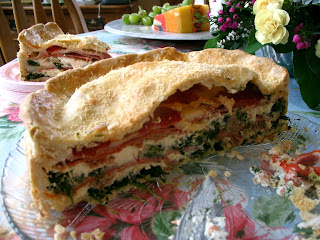 In a somewhat responsible and at times loony Newsweek editorial, famed Los Angeles chef Wolfgang Puck said that from now on he will only serve his customers happy animals. He says he made the change after the Humane Society of the United States, a Washington, D.C.-based animal-welfare organization, approached him about using ingredients “exclusively from humane farmers.” Good for you, Wolfgang!
In a somewhat responsible and at times loony Newsweek editorial, famed Los Angeles chef Wolfgang Puck said that from now on he will only serve his customers happy animals. He says he made the change after the Humane Society of the United States, a Washington, D.C.-based animal-welfare organization, approached him about using ingredients “exclusively from humane farmers.” Good for you, Wolfgang! Of course, in addition to listing some good, practical reasons for the switch, Puck also managed to sound like a chicken-fried hippie. “Why shouldn’t cows and pigs feel sunlight on their backs, grass under their feet?” he asks. “Yes, they’ll be killed for food—but until then they should have a nice stay on Earth.” I guess when you put it that way, I’d rather be a dinner at Spago than a diner, especially when the check comes.
Puck lost me, however, when he blithely mentioned foie gras, a delicacy produced in small quantities in the U.S. almost if not exclusively on artisanal farms but is nevertheless banned in California because of cruelty issues. “My customers and I can easily live without it,” he says.
 That kind of dispassionate, toss-off line makes me wonder what really motivated this editorial. Is this about the hopes and dreams of grill-bound animals? Is it about good, reponsible farming? Or could it be, gasp, that Wolfgang, who's more known for frozen pizza than haute cuisine these days was afraid of losing business?!
That kind of dispassionate, toss-off line makes me wonder what really motivated this editorial. Is this about the hopes and dreams of grill-bound animals? Is it about good, reponsible farming? Or could it be, gasp, that Wolfgang, who's more known for frozen pizza than haute cuisine these days was afraid of losing business?! 
I am all for produce that comes only from “responsible farmers” who grow fruits and vegetables without pesticides or genetic modification. I'm willing to insist on meat from farms that “shun the use of antibiotics and growth hormones and raise their animals humanely.” It’s better for them. It's better for us. And, it’s better for the environment. I sincerely appreciate restaurants like, for example, Cookshop, who already do here in New York what Puck says he will now do in LA.
This editorial, however, is a good example of what I call moral convenience. Why is the artisanal goose farmer taken out with the trash that gives us KFC? At the end of the day, just because you might feel a little better about the life of the chop, don’t think for a second the pig does. If you really want to make a difference, eat locally and stop buying things like, well, frozen pizzas, which have to be individually packaged and then shipped on the pollutant farms we call highways.--F





















